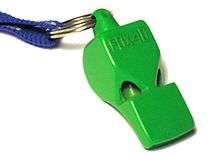Fox 40

Fox 40 International Inc. is a company founded by Ron Foxcroft in Hamilton, Ontario Canada. The company's main success is in the whistle industry but it also produces a range of sports & safety accessories such as mouthguards, coaching boards, custom imprinted products, marine safety products and first aid kits.
History
At the age of 17, Ron Foxcroft's football playing days ended due to a back injury. He went on to become a successful part-time basketball referee. In this capacity, he often had problems with his whistle, which, in refereeing, along with the vertically striped jersey, is an essential piece of equipment. He noticed that the pea inside the whistle caused most of his problems. The pea would prevent him from blowing the whistle hard, or become clogged with dirt and water.[1] He is said to have been inspired to create a "pealess" whistle following an incident in an international game (variously reported as occurring at the 1976 Summer Olympics in Montreal[2] or at a 1984 pre-Olympics game in São Paulo[3]), in which Foxcroft witnessed an obvious foul but he could not stop play as his whistle was rendered useless by a jammed pea; play continued and the referees were booed by spectators.
Foxcroft set out to solve his problem and went to a plastic company looking for a better whistle. The company agreed to help him as long as he provided the design. Foxcroft drew up a list of key features that he wanted included in the whistle design. Foxcroft hired Chuck Shepherd an industrial designer to design the whistle. After more than 14 prototypes the solution was found.[4] Many of the features that Foxcroft drew up in his original list were featured in the final prototype. Foxcroft was adamant that all whistles be painted bright colours, such as pink or yellow, in order to increase visibility of the person blowing the whistle, a statement that mystified Chuck Shepherd. He was eventually able to convince Foxcroft to drop this requirement from his list.[1] Foxcroft and Shepherd were issued patent number 5816186 on Oct 6, 1998 under Ronald Foxcroft & Charles Shepherd.[5]
Foxcroft introduced the Fox 40 whistle to referees at the 1987 Pan American Games in Indianapolis, Indiana. Before the end of the games, Foxcroft had orders for 20,000 whistles.
Fox 40 became the leader in whistle technology selling 10,000 whistles daily in 140 countries.
Pealess technology
The Fox 40 whistle owes its power to pealess technology which was developed by Foxcroft and Shepherd. An ordinary whistle uses a small ball inside of a chamber to create a pulse in the whistle. These whistles produce less sound and they are often jammed by dirt, saliva, water, or ice. A hard blow may cause the pea to stick to the walls of a chamber and produce no sound.[1]
The Fox 40 avoids pea technology and has no moving parts, and therefore it cannot jam or freeze. The Fox 40 can be submerged in water and brought back into the air and blown immediately because the water will drain from the chambers.
It is preferred by mariners, lifeguards, and other people who work under similarly intense conditions. FIFA also recommends that referees use the whistle due to its unique sound and triple chamber design.
The 40 in Fox 40 refers to Foxcroft's age at the time - validated by the fact that Foxcroft patent application was in the same year he reached 40 years of age.
References
- 1 2 3 "Ron Foxcroft - The Story of the Fox 40" (PDF). Retrieved 9 January 2013.
- ↑ "Who We Are: The Fox 40 Story". Fox 40 International. Retrieved 28 August 2012.
- ↑ "Famous, Should be Famous and Infamous Canadians: Ron Foxcroft". Retrieved 2007-02-11.
- ↑ http://medianetcom.com/Divemar/docs/fox_story.html Retrieved on 9 January 2012
- ↑ US patent 5816186, Shepherd, Charles G., "For creating two resonant frequencies resulting in a beat", issued 1998-10-06, assigned to Fox 40 International Inc.